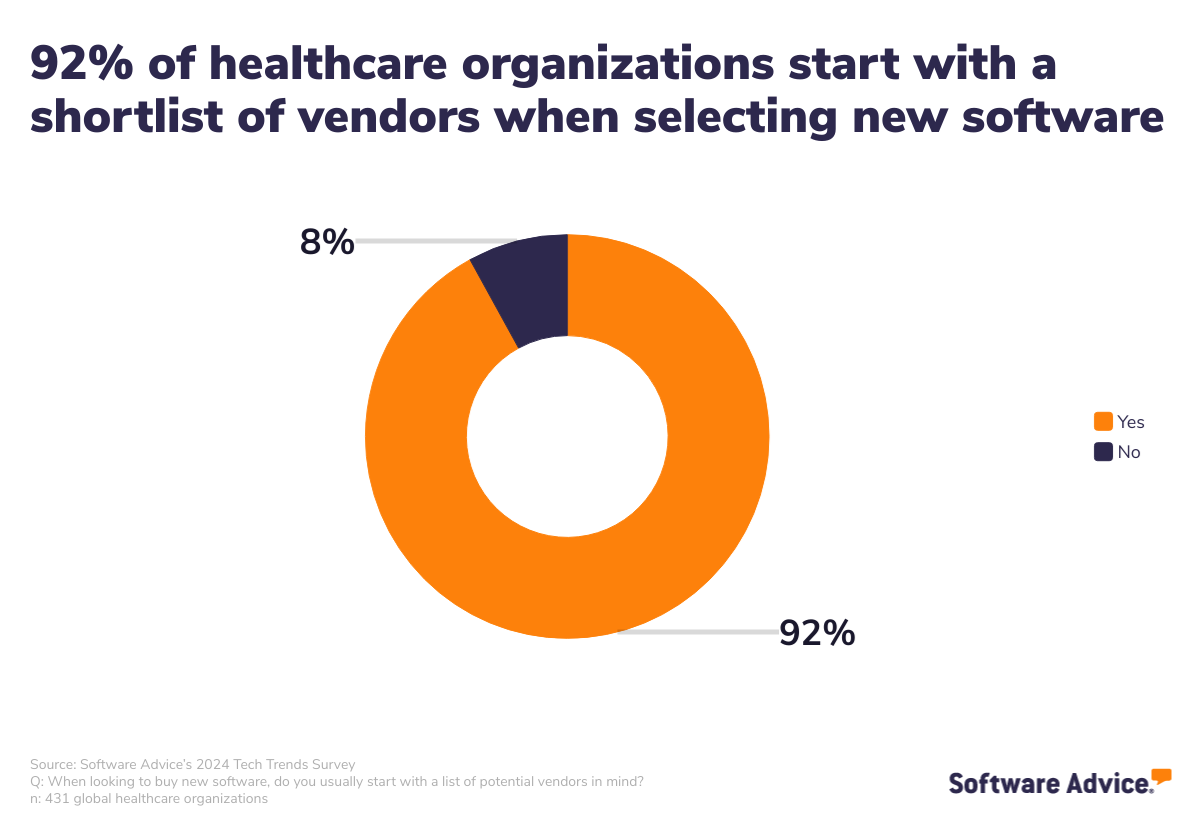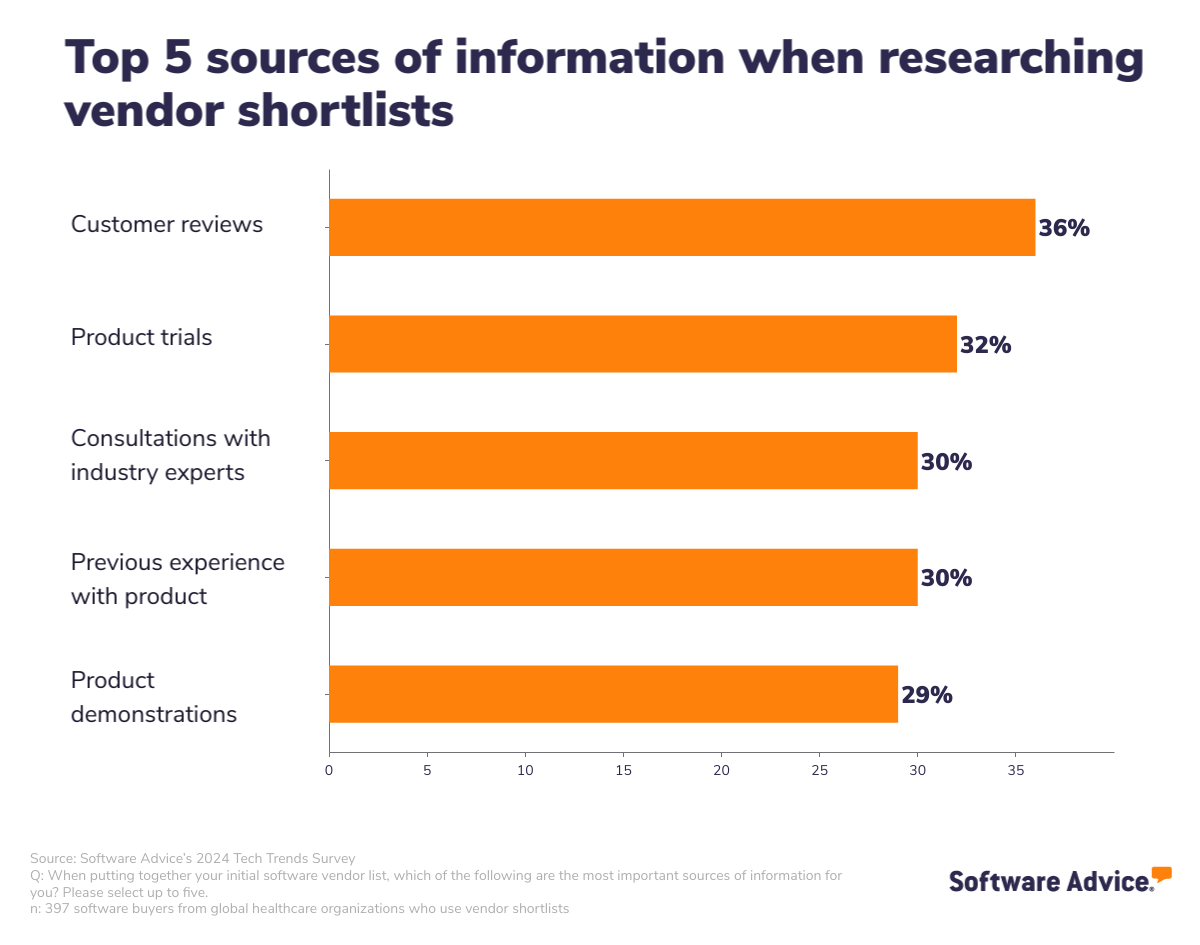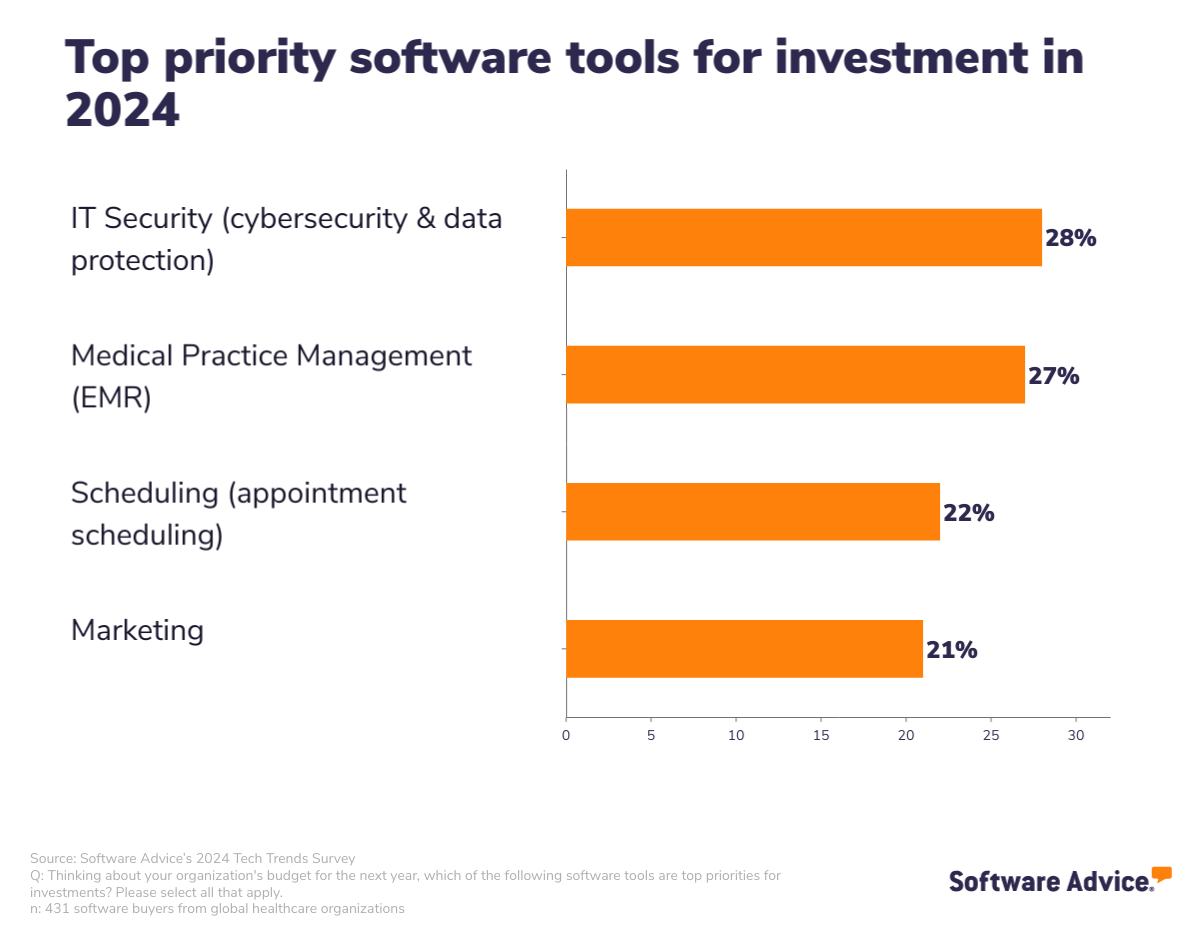Software Advice’s 2024 Tech Trends Report: 3 Global Trends for Medical Software Buyers
Technology is evolving alongside the healthcare industry to help providers overcome current obstacles and continue giving patients the best possible care. But identifying the right technology for your practice is imperative for success. Fortunately, along with that evolving technology comes the information gleaned from other healthcare providers’ experiences with purchasing software—something you can use to make your own decisions.
To help providers understand what other practices are doing in order to feel confident in their own software purchase, Software Advice surveyed 431 software buyers from healthcare organizations all over the world to ask about their experience with purchasing new business software. Using that data, we identified three major trends among medical software buyers that other practices can use as a guide to pick the right software for their needs.
Here’s what we found:
Staffing challenges are a big concern for healthcare orgs: 42% of software buyers from global healthcare organizations say staff acceptance and training is the number one challenge they face when planning investments in new software.
Most healthcare organizations take 3 to 6 months to buy new software: 92% of software buyers from healthcare organizations start the vendor selection process by creating a shortlist of 3-5 vendors, and 59% end up selecting a vendor from their initial shortlist most of the time.
For medical providers, security is still the magic word: IT security is one of the most important software investments for healthcare organizations in the year ahead.
Staffing challenges are a big concern for healthcare orgs
In our global survey, we asked software buyers from healthcare organizations what the three most significant external factors shaping their business goals are right now. The number one selection was the availability of skilled workers.

Similarly, over a third of survey respondents say the top challenge they face heading into 2024 is the training and upskilling of employees. And when it comes to software adoption and application, 42% say staff acceptance and training is the number one challenge they face when planning investments in new software.
The global shortage of qualified healthcare workers is an ongoing challenge, but there are some well established strategies for recruiting and keeping great healthcare employees.
Healthcare work is getting harder to do, and most practices aren’t changing much for their employees to help with this. In order to attract good talent, consider what you’re offering employees. Things like increased pay, more competitive benefits packages, and flexible work options will go a long way in retaining highly sought after healthcare workers.
And as for training employees on new software, one key takeaway here is to prioritize software vendors with strong training features. Look for those who:
Provide guided training sessions
Include training modules in their software
Give plenty of training materials to keep on hand
Are available for calls or chats to answer questions
Most healthcare organizations take 3 to 6 months to buy new software
If you’re not sure how to start the process of selecting new software, the best way is to look at how others are doing it.
Our survey finds that 67% of software buyers from healthcare orgs take between 3 and 6 months to complete the entire software research and selection process, and 92% begin the process by creating a shortlist of vendors. Interestingly, our survey finds that the probability of organizations regretting their software purchase increases for those who take more than three months to make their selection.

For most respondents, this shortlist has 3 - 5 names on it to begin with, and 59% end up selecting a vendor on their initial shortlist most of the time.
Considering these facts, start with a shortlist of three to five vendors and aim to make your final selection within three months of starting.
To create your shortlist, first come up with a list of requirements and then add names that can fulfill those needs to your list. Consider first the specific features you’ll want to use at your practice—this will vary depending on the type of software you’re researching. For example, if you’re looking for a new revenue cycle management system, do you want it to include insurance verification and ICD-11 compliance tracking?
Once you find the vendors that provide the feature set you want, add them to your list. The next step will be to cull the list using the second level of considerations. This includes any data points about the provider that you find important. For example, in our survey we asked respondents what the most important sources of information are when putting together their shortlist. We found that the top one was customer reviews.

With your shortlist in hand, the final step is to reach out to the vendors you’ve narrowed it down to and let them pitch to you. You’ll meet with representatives who will walk you through their software, explain the features and benefits, and provide information about cost, training, security, etc. This is your last shot to vet vendors, so ask all the questions you can think of at this stage.
For medical providers, security is still the magic word
Use of healthcare technology among patients has risen with the growing adoption of telemedicine and other remote patient monitoring tools, and security threats have increased right alongside those adoption rates.
Over 39 million people were affected by healthcare data breaches in the first half of 2023 alone. [1] Not only is this terrible for the patients whose data is exposed in these types of attacks, but healthcare data breaches are among the most expensive of any industry. On average, data breaches across all industries cost an average of $4.45 million; however, the average cost of a healthcare data breach is $10.93 million. [2]
For these reasons, data security is a huge consideration for organizations looking to purchase new business software of any kind.
This bore out in our survey results as well. When asked about their budget for the next year, most respondents selected IT security as the number one priority tool for investment in 2024.

For medical practices, every type of business software that holds patient data must be secure, meaning software vendors have to withstand an additional layer of scrutiny if they want to sell to medical facilities.
And that’s not just limited to EHR and telemedicine platforms—although those require some of the highest security measures. Accounting, business intelligence, scheduling, and even CRM software must have reliable security in order to work for healthcare organizations.
If they don’t, it’s likely to send providers searching for other software options.
The bottom line for practices who are just starting to look for new software is that security matters, regardless of the type of software you’re purchasing. For this reason, you’ll want to make sure you ask specific questions about security features when conducting those vendor interviews.
Key takeaways for healthcare organizations
To recap, the trends identified in our global healthcare survey are:
The employee shortage is a big concern: Prioritize training support when adopting new software to make life easier for your employees, and utilize strategies to attract and retain strong talent.
It takes time to pick a good software vendor: Start by researching vendors and using criteria specific to your practice to create a shortlist, then conduct vendor interviews.
Security should be your focus for the future: Make sure any new (or existing) software you use has strong security features that will protect both your patients from data breaches and you from the high cost of them.
Find more information on selecting the right software or creating a shortlist of vendors that meet your specific needs by connecting with an advisor or browsing our medical resources on Software Advice.
Survey methodology
Software Advice's 2024 Tech Trends Survey was designed to understand the timeline, organizational challenges, adoption & budget, vendor research behaviors, ROI expectations, satisfaction levels for software buyers, and how they relate to buyer’s remorse. The survey was conducted online in July 2023 among 3,484 respondents from the U.S., U.K., Canada, Australia, France, India, Germany, Brazil, and Japan, with businesses across multiple industries and company sizes (5 or more employees). Respondents were screened to ensure their involvement in software purchasing decisions.
Sources
Biggest Healthcare Data Breaches Reported This Year, So Far, Health IT Security
Cost of a Data Breach 2023: Healthcare Industry Impacts, Security Intelligence